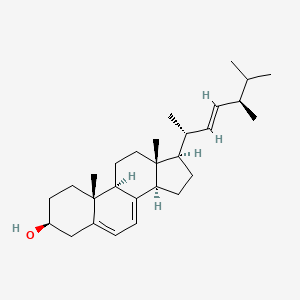Ergosterol
Ergosterol is a lipid of Sterol Lipids (ST) class. Ergosterol is associated with abnormalities such as Disintegration (morphologic abnormality), Consumption-archaic term for TB, Candidiasis, Mycoses and Iodotyrosyl coupling defect. The involved functions are known as Anabolism, sporulation, 5-(carboxyamino)imidazole ribonucleotide mutase activity, Subtraction process and Physiologic Organization. Ergosterol often locates in Pore, Membrane, Protoplasm, Plasma membrane and Endoplasmic Reticulum. The associated genes with Ergosterol are IMPACT gene, BLVRB gene, CYP51A1 gene, CDR1 wt Allele and HM13 gene. The related lipids are Sterols, Cardiolipins, Membrane Lipids, fecosterol and Phosphatidylserines. The related experimental models are Knock-out.
References related to functions published in Appl. Environ. Microbiol.
| PMID | Journal | Published Date | Author | Title |
|---|---|---|---|---|
| 11679327 | Appl. Environ. Microbiol. | 2001 | Suberkropp K | Fungal growth, production, and sporulation during leaf decomposition in two streams. |
| 11319080 | Appl. Environ. Microbiol. | 2001 | Charcosset JY and Chauvet E | Effect of culture conditions on ergosterol as an indicator of biomass in the aquatic hyphomycetes. |
| 12513985 | Appl. Environ. Microbiol. | 2003 | Rosenfeld E et al. | Oxygen consumption by anaerobic Saccharomyces cerevisiae under enological conditions: effect on fermentation kinetics. |
| 12902224 | Appl. Environ. Microbiol. | 2003 | Hietala AM et al. | Multiplex real-time PCR for monitoring Heterobasidion annosum colonization in Norway spruce clones that differ in disease resistance. |
| 12902271 | Appl. Environ. Microbiol. | 2003 | Higgins VJ et al. | Yeast genome-wide expression analysis identifies a strong ergosterol and oxidative stress response during the initial stages of an industrial lager fermentation. |
| 12839740 | Appl. Environ. Microbiol. | 2003 | Murtoniemi T et al. | Effect of plasterboard composition on Stachybotrys chartarum growth and biological activity of spores. |
| 12839773 | Appl. Environ. Microbiol. | 2003 | Reeslev M et al. | Quantifying mold biomass on gypsum board: comparison of ergosterol and beta-N-acetylhexosaminidase as mold biomass parameters. |
| 10618221 | Appl. Environ. Microbiol. | 2000 | Newell SY et al. | Autumnal biomass and potential productivity of salt marsh fungi from 29 degrees to 43 degrees north latitude along the United States Atlantic Coast. |
| 10698779 | Appl. Environ. Microbiol. | 2000 | Sridhar KR and Bärlocher F | Initial colonization, nutrient supply, and fungal activity on leaves decaying in streams. |
| 19897752 | Appl. Environ. Microbiol. | 2010 | Van Leeuwen MR et al. | Water- and air-distributed conidia differ in sterol content and cytoplasmic microviscosity. |
| 20173071 | Appl. Environ. Microbiol. | 2010 | Stefani FO et al. | Impact of endochitinase-transformed white spruce on soil fungal biomass and ectendomycorrhizal symbiosis. |
| 17496128 | Appl. Environ. Microbiol. | 2007 | Verwaal R et al. | High-level production of beta-carotene in Saccharomyces cerevisiae by successive transformation with carotenogenic genes from Xanthophyllomyces dendrorhous. |
| 22904057 | Appl. Environ. Microbiol. | 2012 | Hong KK and Nielsen J | Recovery of phenotypes obtained by adaptive evolution through inverse metabolic engineering. |
| 26150463 | Appl. Environ. Microbiol. | 2015 | Cardoza RE et al. | Effects of Trichothecene Production on the Plant Defense Response and Fungal Physiology: Overexpression of the Trichoderma arundinaceum tri4 Gene in T. harzianum. |
